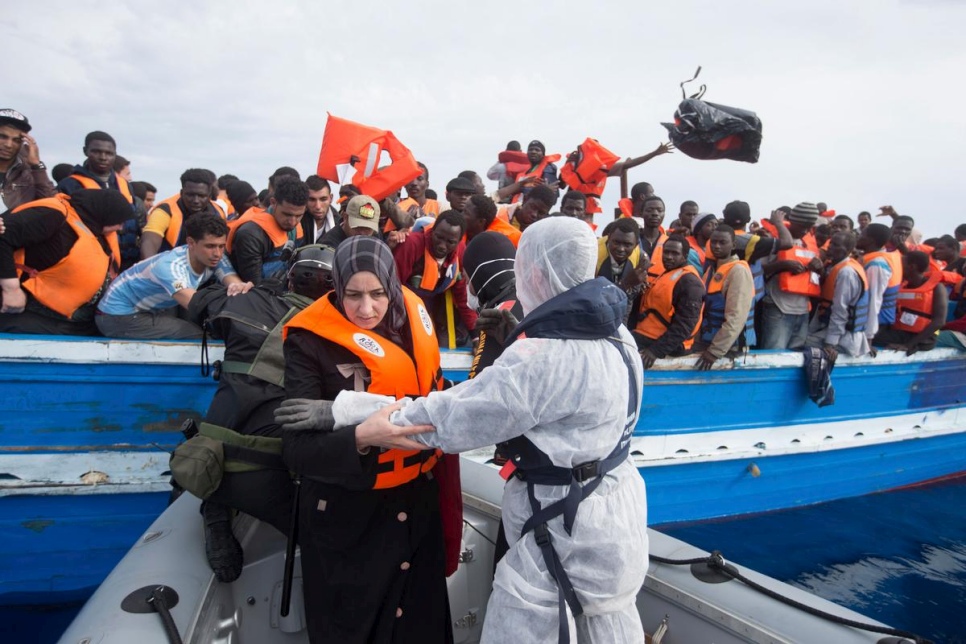By Akanimo Sampson
In the Western Mediterranean, a six-year-old child died during a medical evacuation on October 4. Spanish rescue services had found the boy, along with his mother and 64 other people from Sub-Saharan Africa, on a boat 44 miles south-east of Motril, Granada.
The boy had a low body temperature and had trouble breathing and was medically evacuated with his mother by helicopter to a hospital in Almería, Spain. Tragically, he died before reaching the hospital.
In recent weeks however, the deaths of several dozen people were documented on sea routes across the Mediterranean.
Deaths recorded on the three main Mediterranean Sea routes through over nine months of 2019 are at 1,071 individuals, or about 55 per cent of the 1,930 deaths confirmed during the same period in 2018
In 2019, at least 317 people have lost their lives attempting to reach Spain via the Western Mediterranean.
More recently, on the Mediterranean’s Central route, a boat capsized off the coast of Lampedusa on October 7, killing at least 28 people. The remains of 13 women (including those of a girl aged 12) were recovered from the water, while 15 people remain missing. Twenty-two survivors were rescued and brought to Lampedusa.
While the total number of deaths recorded in 2019 in the Central Mediterranean has decreased, all available data indicate that conditions for those embarking on this journey are worsening. The mortality rate (the number of fatalities as a proportion of attempted crossings) has increased, which means that the risk of dying during this crossing is rising,
In the first nine months of 2019, one in 28 people who attempted the crossing perished. During the same period of 2018, the rate of death was 1 in 32, still a tragic increase from the death rate recorded in 2017, which was 1 in 51
This mortality rate is calculated on the basis of recorded deaths, that is, those deaths which are reported and documented. It is likely that many more deaths happen than are currently recorded – a concerning consequence of the reduced number of dedicated search-and-rescue operations in the Mediterranean is the increased invisibility of migrant deaths. In this context, the risk that shipwrecks are occurring far from the eyes of the international community has intensified.
International Organisation for Migration (IOM) reports that 76,558 migrants and refugees have entered Europe by sea through October 9, roughly a 13 per cent decrease from the 87,923 arriving during the same period last year.
Arrivals this year to Greece and Spain are at 41,321 and 19,443 respectively, (60,764 combined) accounting for almost 80 per cent of the regional total, with the balance arriving in much smaller numbers to Italy, Malta and Cyprus. Arrivals to Greece are running approximately 70 per cent ahead of 2018’s totals from this time. Arrivals to Spain are more than 50 per cent lower.
Missing Migrants Project
2019 is the sixth year of IOM’s efforts to systematically record deaths on migration routes worldwide through its Missing Migrants Project. Since the beginning of 2014, the project has recorded the deaths of 33,631 people, including 2,469 in 2019.
Due to the challenges of collecting information about these people and the contexts of their deaths, the true number of lives lost during migration is likely much higher. Missing Migrants Project records should only be viewed as indicative of the risks associated with migration, rather than representative of the true number of deaths across time or geography.
On the US-Mexico border, the deaths of six people were reported since last week’s update. Two deaths due to dehydration were reported on the US side of the border. On October 2, the remains of a young Mexican man, who had been reported missing by his family, were found in a ranch in Webb County, Texas. Just two days later, a 25-year-old man from Guanajuato, Mexico, died while traversing through a remote stretch of land in Dimmit County, also in Texas.
At least 45 people have reportedly died of weather exposure on the US-Mexico border in 2019. Additionally, four men drowned in the Río Bravo between October 3 and 7 while attempting to reach Texas from Tamaulipas. Their remains were recovered on Mexican riverbanks. Since the beginning of 2019, the deaths of 101 people have been documented in the Río Bravo. This figure is already higher than the total number of drownings (87) recorded in the Río Bravo for all of 2018.
Across all four corridors in the Americas, MMP so far in 2019 has recorded 608 deaths, compared with 466 at this point last year, an increase of 30 per cent.
Elsewhere: in Europe, three people were killed in a car accident in northern Greece this week, when a van in which 11 migrants were travelling overturned near the town of Areti, located 40km northeast of Thessaloniki. That accident occurred on October 9. Of the 52 deaths documented on the European continent in 2019, 33 per cent have been due to vehicle accidents.
Missing Migrants Project data are compiled by IOM staff based at its Global Migration Data Analysis Centre but come from a variety of sources, some of which are unofficial. To learn more about how data on migrants’ deaths and disappearances are collected, click here.
The report Fatal Journeys Volume 4, published 28 June, includes an overview of five years of Missing Migrants Project data (2014-2018) and an update on what is known about deaths during migration in 2019.

